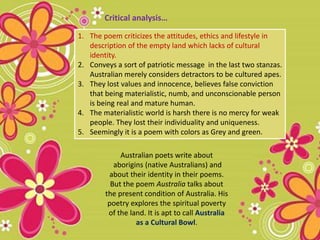Australia poem by A D Hope
- 1. S. Mohan Raj M.A., M.Phil, B.Ed., Assistant Professor, Indo -American College, Cheyyar. Available @ : 9751660760 E-mail: rajmohan251@gmail.com AUSTRALIA - A.D.HOPE
- 2. He was educated at home also at Tasmania and New South Wales Matriculating to Sydney University, he graduated Bachelor of Arts with two majors (English and Philosophy). In 1937 Hope married Penelope Robinson with whom he had three children. He was appointed lecturer in education at the Sydney Teachers' College in 1937, later becoming lecturer in English there from 1938-44. Biography Alec Derwent Hope was born on 21 July 1907 at Cooma, in the New South Wales, where his father was a Presbyterian minister. In 1928 won a scholarship to University College, Oxford. In 1945 he moved to the University of Melbourne. In 1951 was appointed as Professor of English at Canberra University College (later the Australian National University) where he taught until his retirement in 1968.
- 3. Hope did not publish any of his poems until the 1930s. His first collection, The Wandering Islands, did not appear until 1955. It was praised for Hope's skilful use of traditional verse forms and received the Grace Leven Poetry Prize. Biography… His second collection, Poems (1960), was published in London. For many years Hope was the best-known Australian poet internationally, appearing in many anthologies. Got many honors and awards In 1965 the Arts Council of Great Britain Poetry Award, in 1968 the Levinson Prize for Poetry (Chicago) and in 1969 the Ingram Merrill Award for Literature (New York). In 1981 he had been made a Companion of the Order of Australia for services to literature. After some years in a Canberra nursing home, he died on 13 July 2000. Hope was a widely published critic, reviewer and editor.
- 4. Background The poet says, Australia is a country filled with migrating people who came from many parts of the world. The author wanted to convey their manners and really what they were. The first five stanzas dealt with how the Australia was. There was sarcasm in final line which implied ‘cultural apes’. He said that Australia was a mechanical and monotonous land. In this poem his country was intentionally traumatized by author. The poem gave negative perception and affected the life of survival in Australian country. The poem reflected the lack of individualism and spiritual poverty. It was the continent with ambiguous state.
- 5. Critical analysis “A nation of trees, drab green and desolate grey” The first stanza conveyed that the trees in Australia were seemed dull which stood in a desolate place. Generally NATURE was a charm thing but here it looked desolated, Nobody cared about it, as Many people gave importance to face only. They didn’t care about inner heart. The author compared this character as ‘Sphinx’. “And her five cities, like five teeming sores, Each drains her…” Five teeming sores indicate Melbourne, Sidney, Perth, Canberra and Adelaide. The people in these were not had their own identity. They were like parasites which dependent on others. The people in Australia were homogenous. The author called them as Young but it ironically conveyed immature. They were not creative and independent. The people in this continent were not living, they were surviving.
- 6. 1. The poem criticizes the attitudes, ethics and lifestyle in description of the empty land which lacks of cultural identity. 2. Conveys a sort of patriotic message in the last two stanzas. Australian merely considers detractors to be cultured apes. 3. They lost values and innocence, believes false conviction that being materialistic, numb, and unconscionable person is being real and mature human. 4. The materialistic world is harsh there is no mercy for weak people. They lost their individuality and uniqueness. 5. Seemingly it is a poem with colors as Grey and green. Australian poets write about aborigins (native Australians) and about their identity in their poems. But the poem Australia talks about the present condition of Australia. His poetry explores the spiritual poverty of the land. It is apt to call Australia as a Cultural Bowl. Critical analysis…
- 7. @ Each stanza consists of four lines with the rhyme scheme being ABBA. @ Little enjambment exists in the poem; most of the stanzas stand alone as paragraphed. @ A.D Hope uses imagery as a means to convey meaning to the poem. @ The dark colors portray the insipidness of the landscape. @ Monotonous tribes refer to the fact that there is no individualism throughout Australia everyone looks and thinks the same. @ The alliteration helps to once again convey an image ' drab green and desolate grey'. @ A. D Hope uses the metaphor to give the concrete reality that Australia does have human qualities an abstract idea. @ The tone is mocking Australian culture, our history, our land and they way we live our life. Poetical Devices
- 8. The poet is hopeful. He ends the poem with a positive note. He says that some prophet would emerge or come from the Australian ground, who would claim freedom and rights to liberate the aborigins and Australian culture from the colonisers.
- 9. Thank You








